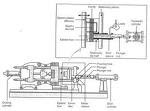PLASTICITY is that state of matter where permanent deformations or strains may occur without fracture. A material is plastic if the smallest load increment produces a permanent
deformation. A perfectly plastic material is nonelastic and has no ultimate strength in the ordinary meaning of that term. Lead is a plastic material. A prism tested in compression will deform permanently under a small load and will continue to deform as the load is increased, until it flattens to a thin sheet. Wrought iron and steel are plastic when stressed beyond the elastic limit in compression. When stressed beyond the elastic limit in tension,
they are partly elastic and partly plastic, the degree of plasticity increasing as the ultimate strength is approached.
STRESS–STRAIN RELATIONSHIP gives the relation between unit stress and unit strain when plotted on a stress–strain diagram in which the ordinate represents unit stress and the abscissa represents unit strain. Figure 5 shows a typical tension stress–strain curve for medium steel. The form of the curve obtained will vary according to the material, and the curve for compression will be different from the one for tension. For some materials like
cast iron, concrete, and timber, no part of the curve is a straight line.
PROPORTIONAL LIMIT is that unit stress at which unit strain begins to increase at a faster rate than unit stress. It can also be thought of as the greatest stress that a material can stand without deviating from Hooke’s law. It is determined by noting on a stress–strain diagram the unit stress at which the curve departs from a straight line.
ELASTIC LIMIT is the least stress that will cause permanent strain, that is, the maximum unit stress to which a material may be subjected and still be able to return to its original form upon removal of the stress.
JOHNSON’S APPARENT ELASTIC LIMIT. In view of the difficulty of determining precisely for some materials the proportional limit, J. B. Johnson proposed as the ‘‘apparent elastic limit’’ the point on the stress–strain diagram at which the rate of strain is 50% greater than at the origin. It is determined by drawing OA (Fig. 5) with a slope with respect to the vertical axis 50% greater than the straight-line part of the curve; the unit stress at which the line O A which is parallel to OA is tangent to the curve (point B, Fig. 5) is
the apparent elastic limit.
YIELD POINT is the lowest stress at which strain increases without increase in stress. Only a few materials exhibit a true yield point. For other materials the term is sometimes used as synonymous with yield strength.
YIELD STRENGTH is the unit stress at which a material exhibits a specified permanent deformation
or state. It is a measure of the useful limit of materials, particularly of those whose stress–strain curve in the region of yield is smooth and gradually curved.
ULTIMATE STRENGTH is the highest unit stress a material can sustain in tension, compression, or shear before rupturing.
RUPTURE STRENGTH, OR BREAKING STRENGTH, is the unit stress at which a material breaks
or ruptures. It is observed in tests on steel to be slightly less than the ultimate strength because of a large reduction in area before rupture.
MODULUS OF ELASTICITY (Young’s modulus) in tension and compression is the rate of change of unit stress with respect to unit strain for the condition of uniaxial stress within the proportional limit. For most materials the modulus of elasticity is the same for tension and compression.
MODULUS OF RIGIDITY (modulus of elasticity in shear) is the rate of change of unit shear stress with respect to unit shear strain for the condition of pure shear within the proportional limit. For metals it is equal to approximately 0.4 of the modulus of elasticity.
MECHANICAL DESIGN
Mechanical Engineers’ Handbook: Materials and Mechanical Design, Volume 1, Third Edition.
Edited by Myer Kutz
Copyright 2006 by John Wiley & Sons, Inc.
















